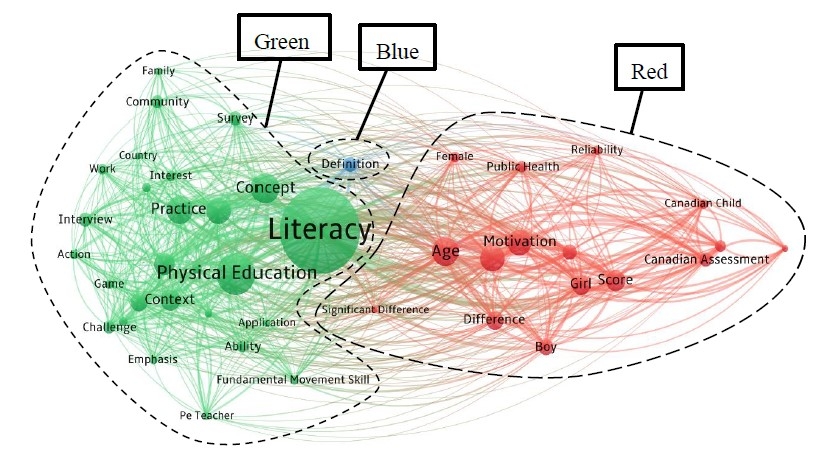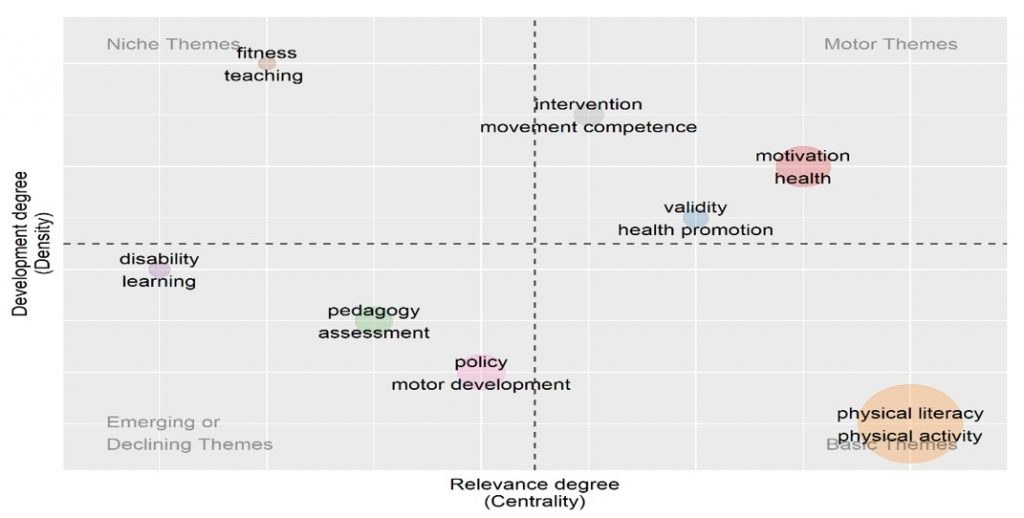“This article was provided by the research team of Associate Professor Chang, Ching-Wei from the Department of Physical Education and Sport Sciences.”
(English Version Powered by ChatGPT, Edited by Serena H.)
In recent years, the concept of physical literacy has received increasing attention within the fields of physical education and sports science. This study explores the bibliometric characteristics of international publications on physical literacy between 2010 and 2020. Using the Scopus database, the keyword “physical literacy” was searched (as of May 27, 2021). The analysis was conducted using VOSviewer and the Bibliometrix R package, focusing on annual publication trends, country and journal publication volumes, author contribution metrics, co-occurrence network analysis.
The key findings showed that:
- 250 articles were published across 39 countries and 97 journals.
- 2018 marked the year with the highest citation count; 2020 saw the peak in publication volume.
- Top publishing countries: Canada, the United States, and the United Kingdom.
- Most articles appeared in journals related to physical education and public health.
And we can highlight five core themes through highly cited articles: Physical education, conceptual development, motivation, age, and definitions. This study concludes that physical literacy has been developing rapidly and continuously within the field of physical education research, with recent studies covering a broad range of related topics. Ongoing debates over the definition of physical literacy have sparked numerous developmental studies, while the concept of assessment continues to evolve to encompass more diverse values and the notion of a lifelong journey. Future research may focus on in-depth exploration of individual variables or emerging issues; meanwhile, continues to track and review of related models of physical literacy.
The Conceptual Multiverse of Physical Literacy
Physical literacy is now embedded in the curriculum frameworks of nations such as England, Canada, United States, Scotland, Australia, New Zealand, etc. As a result, it has also led many sports science institutions and professionals in various countries to continuously explore the concept of physical literacy—particularly as it encompasses a wide range of philosophical perspectives such as existentialism, phenomenology, and mind-body monism. In summary, physical literacy is supported by both theoretical rigor and practical application.
However, varied interpretations across sectors come with differences, and this kind of development in pluralism is best understood through the lens of cosmopolitics, which treats each disciplinary lens as a “parallel universe” with distinct logic and boundaries. In the field of physical literacy, sectors such as public health, education, sports, and medicine are just like “parallel universes” which is good for its own progression.
Even so, one must pay attention to the obscurity of the boundaries between the parallel universes, otherwise misunderstanding and contestation might occur due to the confusion of all the different ideas. This diversity can enrich discourse, but also risks conceptual confusion. Thus, researchers must interpret physical literacy with precision and context sensitivity.
Based on this, the present study adopts a bibliometric approach to comprehensively organize and review academic publications and the knowledge structure related to physical literacy from 2010 to 2020. Through the analysis of various bibliographic data, it meticulously presents visualized network maps and data results to assist relevant stakeholders in understanding the development and evolution of physical literacy as a concept. Ultimately, the study included and analyzed 250 academic journal articles. From the visualized knowledge network of physical literacy (Figure 1, see below), three main research backgrounds can be identified.
First, the red cluster represents demographic analyses, including gender, age, and measurement scales and perceived motivation assessments used in Canada. Second, the green cluster reflects research topics primarily from Australia and the United States. In recent years, Australia has focused heavily on the implementation of the concept and content of physical literacy in school physical education, including interviews to understand perspectives within schools and the development of related scales. The United States, on the other hand, has concentrated on individuals’ fundamental movement skills and examining whether there are significant variations in physical competence.
Interestingly, the blue cluster stands alone in defining a specific dimension. This is because, since the concept of physical literacy emerged in 2010, different countries have interpreted and applied it in their own ways under diverse philosophical frameworks. The term has been adopted across public health, medical, and physical activity domains, resulting in a wide range of interpretations and continuously evolving definitions.
Additionally, through bibliometric analysis, four developmental quadrants of physical literacy research can be identified: core themes, highly developed and independent themes, emerging or declining themes, and foundational and transversal themes (Figure 2). The results indicate that, in recent years, there has been a growing inclusion of social and cultural perspectives in physical literacy. At the same time, bibliometric methods provide empirical explanations for the diverse scholarly camps, helping to clarify the conceptual framework of physical literacy’s knowledge structure.
About the Authors
Hong-Ying Lee
Ph.D. Candidate | Department of Physical Education and Sport Sciences, NTNU
Focus: PE teacher training, curriculum design, tech-enhanced PE instruction, TPACK, design thinking, and physical literacy.
Published over 10 peer-reviewed articles in domestic and international journals.
Ching-Wei Chang
Associate Professor | Department of Physical Education and Sport Sciences, NTNU
Roles:
- Deputy Secretary-General, Chinese Taipei Society of Sport Sciences
- Secretary-General, Taiwan Association of Sport Education
- Member, National PE Curriculum Advisory Committee
Focus: Sport pedagogy, teacher education, physical literacy, and curriculum development.
Author of over 50 journal articles and academic books.

